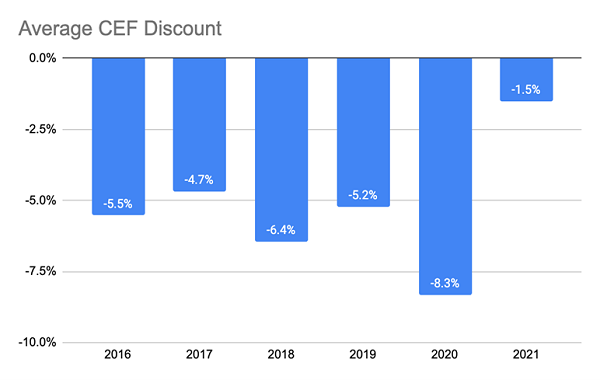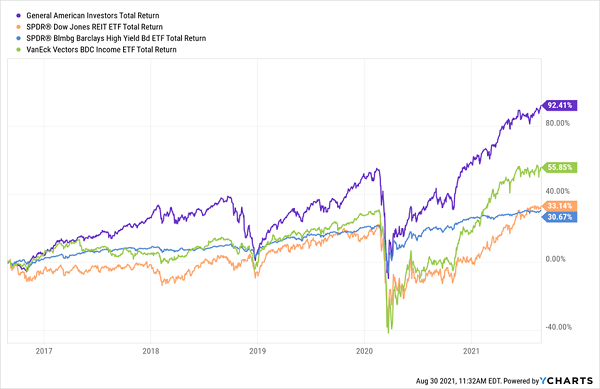If anyone tells you that all the big dividends have been bought up in this inflated market, do yourself a favor: tune them out.
Because while stocks are up—and dividend yields are down as a result—there are still high, cheap payouts to be had out there. And we closed-end fund (CEF) investors know exactly where to find them. In a moment, we’ll nail down a couple of funds that are still attractively priced today, and they pay you 6%+ dividends, to boot.
That said, deals certainly aren’t falling out of trees in CEFs these days—we have to dig deeper to uncover them than we ever have before. That’s because even our quiet little corner of dividend-land has found its way on to mainstream investors’ radar.
CEFs Soar—and They Still Have Room to Run
Like RVs and bicycles, our favorite 6%+ paying funds are having a moment, and nearly every single metric you look at says so, starting with the clearest one of all: CEFs’ assets under management, which have leapt from their five-year average of between $250 billion and $280 billion to $375 billion as of the end of August 2021.
That’s a massive spike for a tiny market like CEFs (for a bit of context, consider that ETFs have $5.5 trillion in assets).
Part of that jump is due to profits in CEFs, which are having a strong year, with a 12.4% total return on average since early January. That’s a strong run for relatively steady income investments like CEFs, and we see these gains across the board, with even my CEF Insider service’s Tax-Free Bond Subindex (which tracks CEFs holding ultra-stable municipal bonds) up more than 6%.
CEFs Deliver Strong Returns in ’21

Source: CEF Insider
This is obviously great news for CEFs we already own. But as with everywhere else in investing, it’s left us with fewer bargains to buy, as discounts to net asset value (NAV, or the value of the holdings in CEFs’ portfolios) shrink to their lowest level in five years.

Source: CEF Insider
What’s more, 41.9% of all CEFs now trade at par or at premiums, another record. The reason why is simple: big yields! The average CEF pays 6% now, crushing the meager 1.3% payouts you get on stocks and US Treasuries.
CEFs: A Great Play for “1-Click” Diversification—or to Play Certain Sectors
High yields aren’t the only reason why we love CEFs, of course. Out of the entire high-yield universe (and here I’m including asset classes like business development companies, or BDCs, and real estate investment trusts, or REITs), they’re the only ones that let you tap into a wide range of investments, or across different geographic regions, in one buy. And you get the expertise of seasoned fund managers, too.
You can see that diversification in action through a CEF like General American Investors (GAM), whose portfolio includes Microsoft (MSFT), waste-management firm Republic Services (RSG) and semiconductor-industry supplier ASML Holding (ASML), the latter of which is up a colossal 111.5% from a year ago.
GAM’s smartly built portfolio has helped it outperform the benchmarks for REITs (in orange below), BDCs (in green) and corporate bonds (in blue) over the last five years:
GAM Beats the High-Yield Alternatives

As you can see, GAM has outperformed all of the other high-yield options out there. And it’s done so while yielding over 6% the entire time. And today we can buy this fund at a 16.4% discount to NAV, or about 84 cents on the dollar, in other words.
CEFs are also a great choice if you don’t want all-in-one diversification, like GAM offers, but instead want to target certain sectors of the economy.
A good example of a more sector-specific CEF is the 6.1%-yielding Nuveen NASDAQ 100 Overwrite Fund (QQQX), which holds the stocks in the tech-laden NASDAQ 100 Index and sells call options on its portfolio. Selling calls is a savvy strategy that lets the fund pull in additional income, which it hands to us in the form of its large payout.
Selling calls does limit the fund’s upside somewhat (it tends to underperform the NASDAQ, for example), but in return this strategy offers greater stability and supports QQQX’s high dividend, which is 13 times bigger than the payout on the typical NASDAQ stock. Plus, QQQX has delivered a sparkling 125% total return in the last five years
QQQX Shines, With More Dividend Cash, Less Volatility

QQQX does trade at a premium. But at 0.6%, it’s barely above par, so you’re not at risk of overpaying, especially when this fund has traded at premiums as high as 4.3% in the past year.
5 CEFs That Pay You 7.3% (With Fast 20% Upside Ahead)
Here’s the best part of this story: I’ve assembled a 5-CEF portfolio that pays you much more than either of these two funds—an outsized 7.3% average payout. And you can buy all 5 of these funds at much more attractive prices, too!
I’m ready to share full details on all 5 of these potent 7.3%-paying income plays with you now. You can get full access to all of them right here.
So what can we expect from these 5 bargain-priced income machines? How does 20% price gains in the next 12 months sound? And that’s in addition to their huge 7.3% average dividends.
Don’t miss this unique opportunity. Click here to get everything I have on all 5 of these high-yielding CEFs, including names, tickers, best-buy prices and my full analysis of each one.
